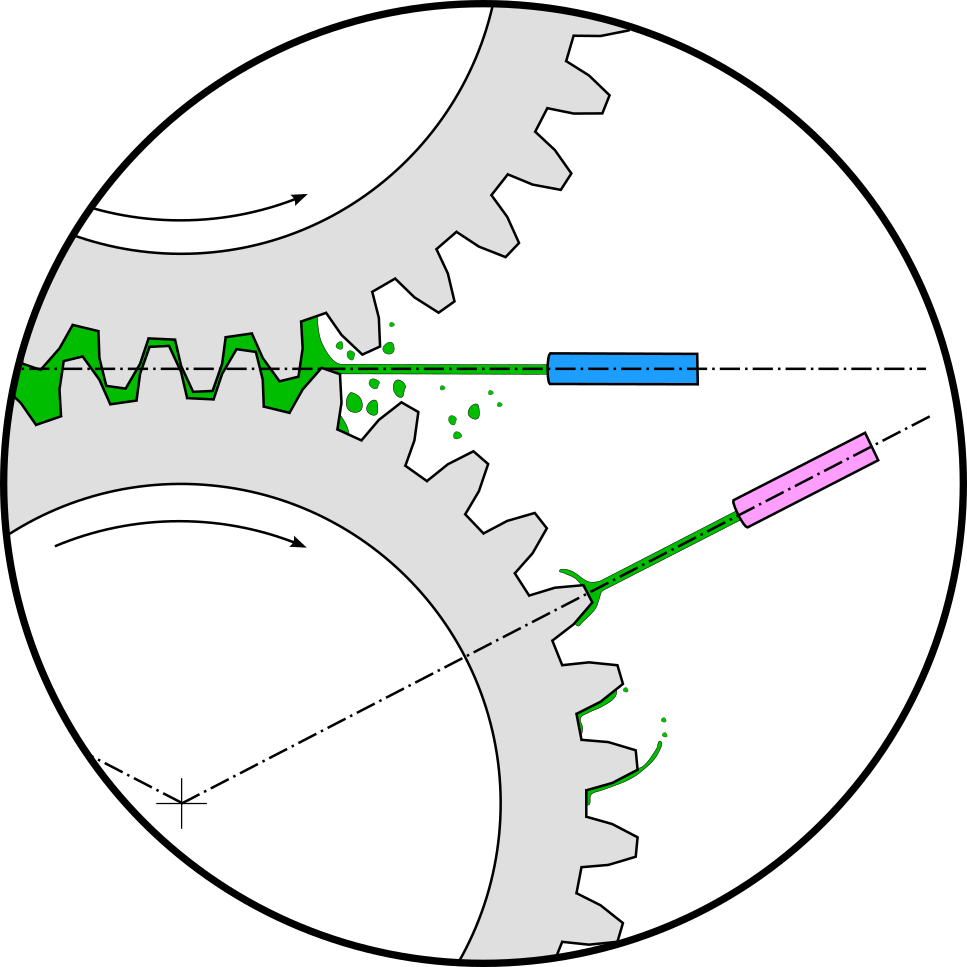Overview
The planetary gearbox has established itself as an instrumental component for a more efficient engine design in the form of the geared turbofan engine. The planetary gearbox located between the low-pressure turbine and the fan (cf. Figure 1) allows these components to be operated in their optimum speed range. The heat generated in the gearbox during power transmission must be dissipated as effectively as possible to ensure safe operation. Nevertheless, the cooling design is based to a large extent on empirical values, as the complex heat transfer mechanism for the injection cooling of high-speed gears is not sufficiently described.
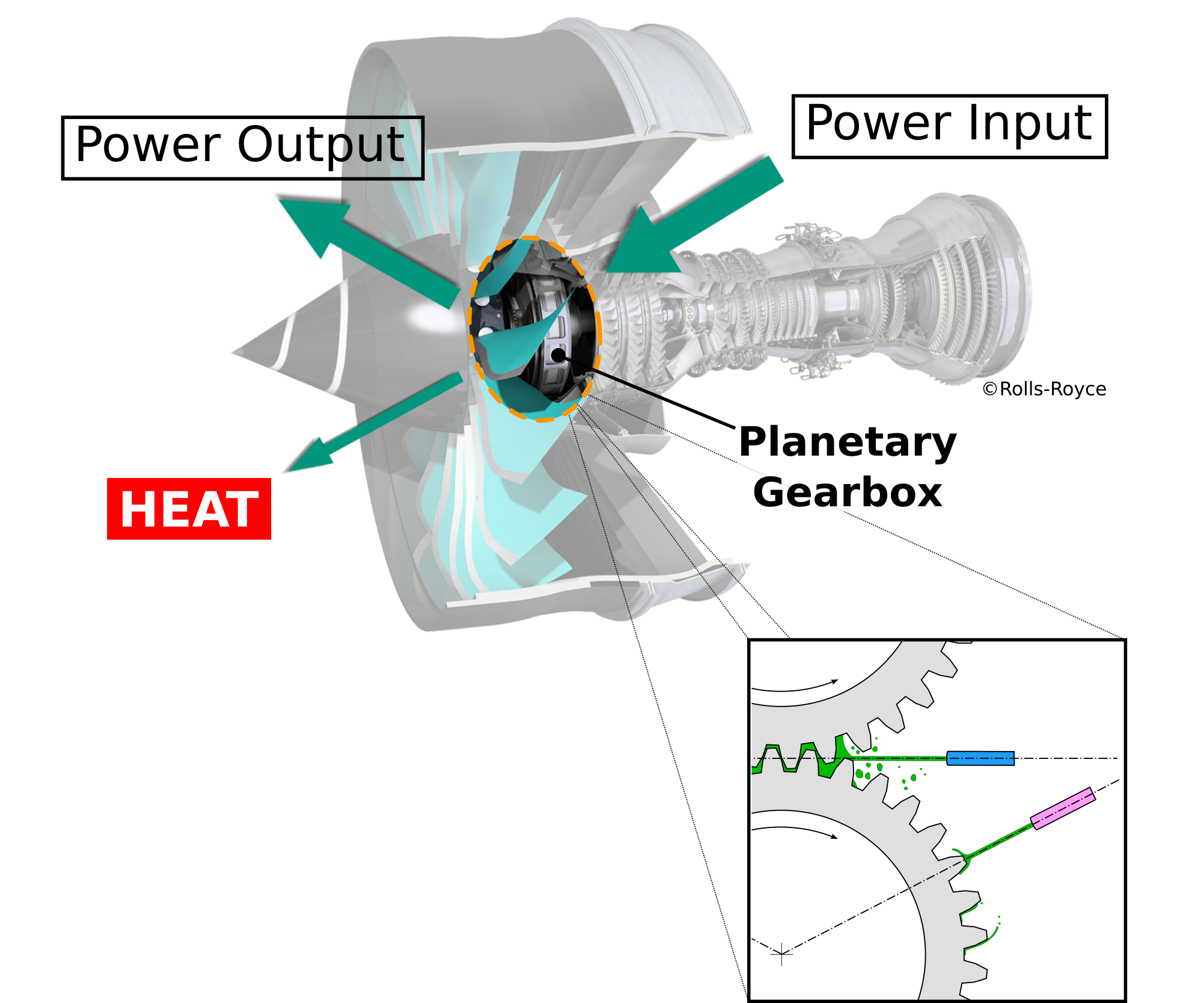
Figure 1: The gear fan and schematic representation of injection lubrication and cooling
The Institute of Thermal Fluid Machinery (ITS) is investigating the heat transfer and flow behavior during injection cooling. Both numerical methods and experiments on the impingement cooling test rig are used.
Numerical investigations using CFD
The investigation of injection cooling is also being driven forward at the ITS using computational fluid dynamics (CFD). The focus of the CFD investigations is on analyzing the fundamental flow mechanisms when oil jets collide with high-speed gears. This process occurs in the oil system of geared turbofan engines, where it plays a key role in determining the cooling effect achieved. The numerical investigations are complementary to the experimental and analytical work at the ITS.
Aims and procedure
The focus of the investigation is the characterization of the OCI, the oil distribution over the gear flanks and the heat transfer process. To this end, the numerical simulation models will first be created and the applicability of suitable CFD methods evaluated. Subsequently, the influence of various operating parameters, such as the jet velocity, the jet diameter and the gear wheel speed, on the ETI will be investigated. The results are always linked to the experimental and analytical investigations on the ITS and contribute to the development of understanding and the creation of easily applicable design guidelines in practice.
Challenges
Due to the strong interaction of the oil jet with the high-speed gear, a complex two-phase flow is formed, which is characterized by a large time and length scale range (μm -cm / ns - μs). The challenge in numerical modeling is to capture the flow process in sufficient (spatial and temporal) detail while keeping the computational effort low to enable extensive parameter studies. The flow process is strongly influenced by the kinematics of the gear system (gear rotation), the consideration of which in the CFD simulations leads to deforming computational domains and represents a further challenge in numerical modeling.
- Highly dynamic, complex two-phase flow
- Large range of length and time scales
- Large density ratios (≳1000)
- Deforming computational domain (due to gear rotation or gear mesh)
Methods
Thanks to many years of experience in modeling complex multiphase flows at the ITS, different methodological approaches can be used in this project. Specifically, the following CFD methods are used:
| Volume-of-Fluid (VoF) | Smoothed Particle Hydrodynamics (SPH) |
|
|
Results
The simulation results obtained in this context represent the most detailed CFD simulations of this flow process to date and enable a comprehensive quantitative characterization of the OCI for the first time. In Figure 2 shows exemplary simulation results. For further explanations and results of the numerical work on the ITS, please refer to the references given.
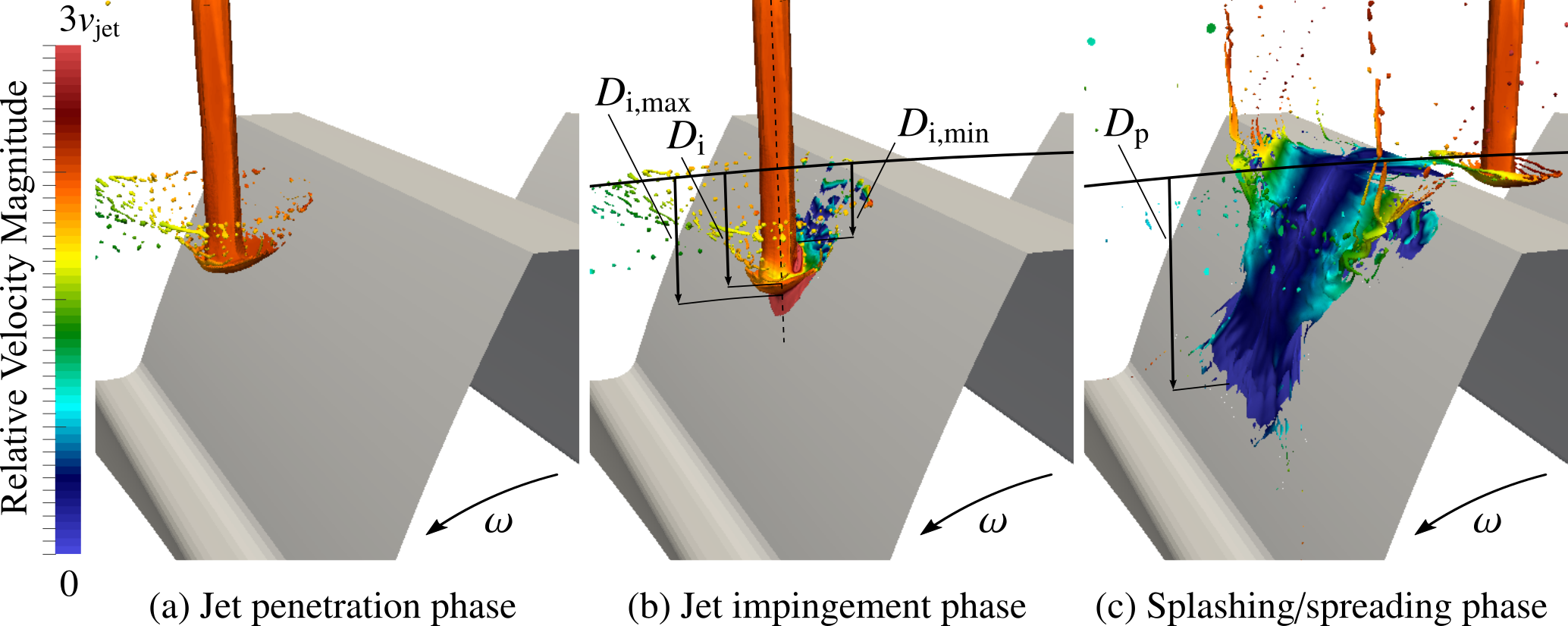
Figure 2: Exemplary simulation result -- oil distribution for three flow phases of the ECI
[Source: Keller et al. (2020): CFD study of oil-jet gear interaction flow phenomena in spur gears. In: The Aeronautical Journal. DOI: 10.1017/aer.2020.44]
Experimental investigations
The heat transfer during the injection cooling of a rotating gear is investigated on the impingement cooling test rig at the ITS. The injected oil supplies heat to the gear wheel via the tooth flanks, while the hollow gear wheel is cooled internally by air impingement cooling. The temperature is measured both on the tooth flanks and on the inner surface using thermocouples. The heat transfer coefficient on the tooth flank is determined using an iterative evaluation procedure based on the finite element method. The investigations serve to provide the first experimental findings on the spatially resolved heat transfer coefficient on the tooth flank. The influence of various operating parameters on the mean heat transfer coefficient and its local distribution is investigated in order to expand the understanding of the underlying heat transfer mechanism and to derive design guidelines for an optimum cooling solution.
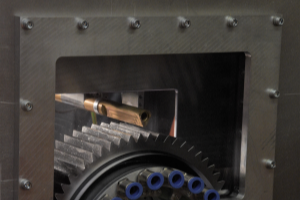
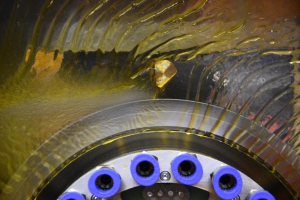
Figure 3: Views of the impingement jet test rig
In addition to the experimental investigation of the oil jet-gear interaction, the impingement cooling of a rotating cylinder is being fundamentally investigated on the ITS. This test setup is intended to identify the dominant factors influencing the impingement cooling of moving walls. The findings will be used to improve the injection cooling of the gearwheel.
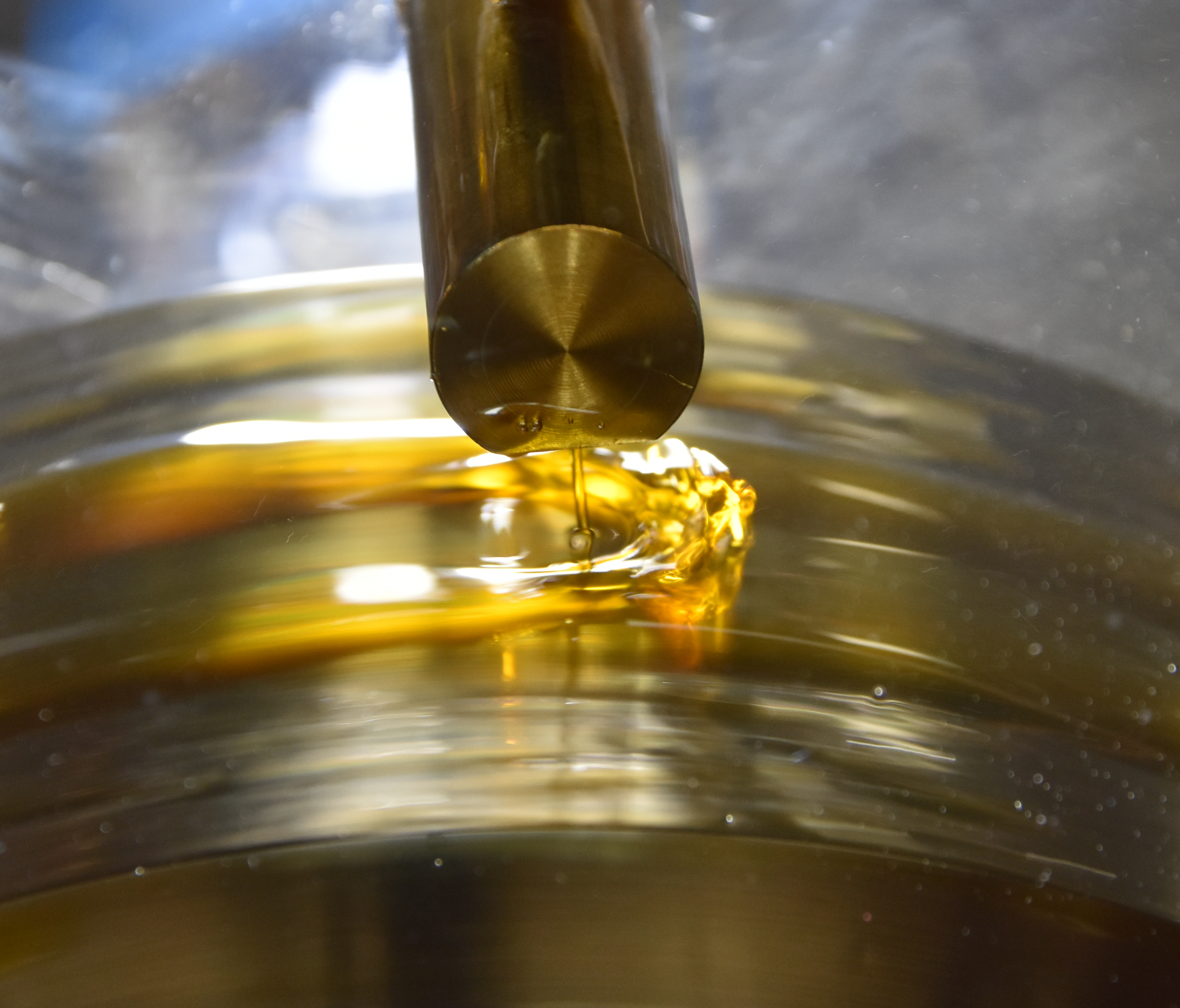
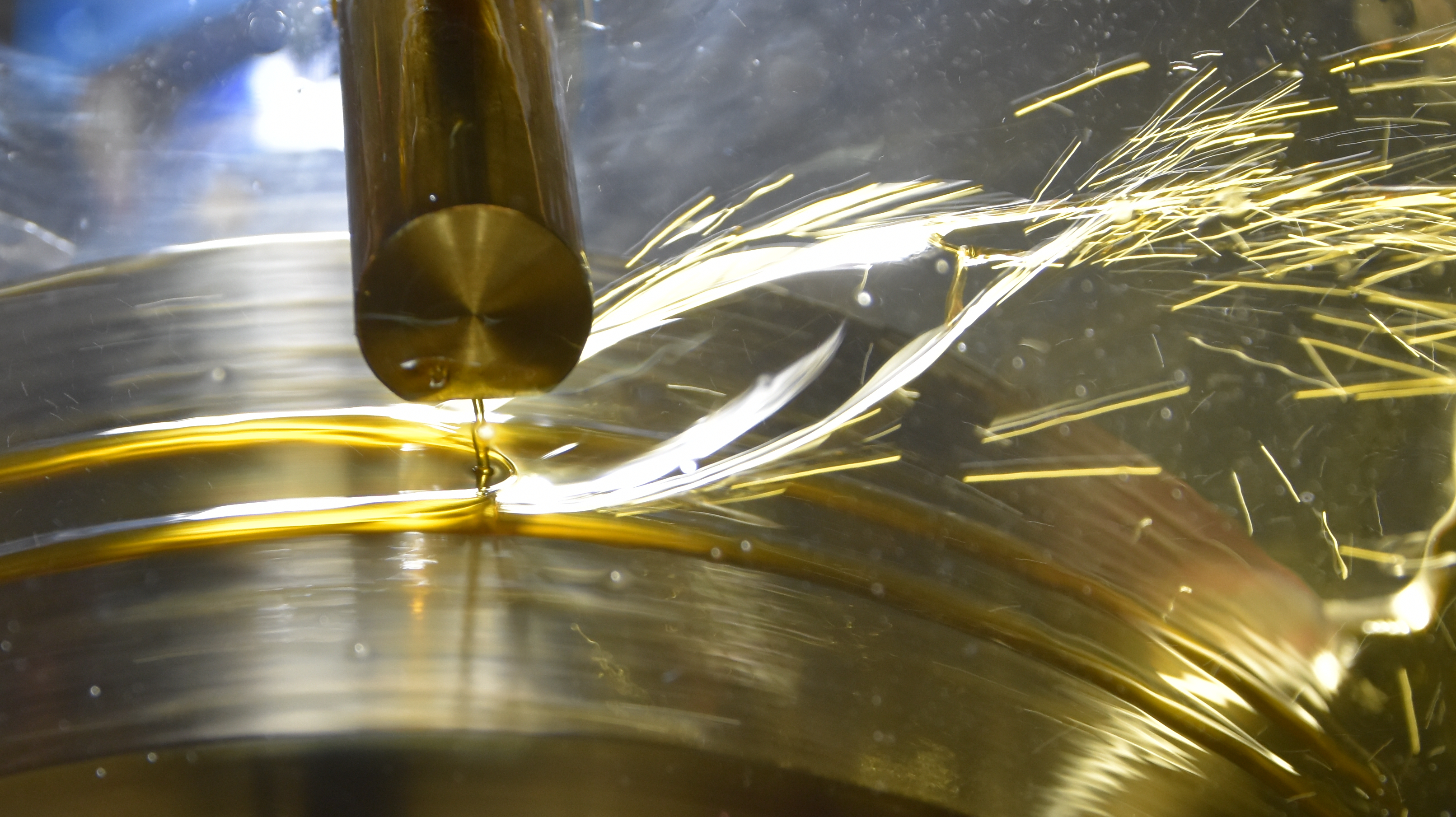
Figure 4Experimental investigation of the impingement cooling of a rotating cylinder
Sources and relevant publications
Ayan, E.
2025, April 24. Karlsruher Institut für Technologie (KIT). doi:10.5445/IR/1000181270
Keller, M.
2023, January 24. Logos Verlag Berlin
von Plehwe, F. C.
2022, February 22. Logos Verlag Berlin. doi:10.30819/5436
Keller, M.
2022. Logos Verlag Berlin. doi:10.30819/5582
Ayan, E.; von Plehwe, F. C.; Keller, M. C.; Kromer, C.; Schwitzke, C.; Bauer, H.-J.
2022. Journal of Turbomachinery, 144 (8), Art.-Nr.: 081008. doi:10.1115/1.4053694
Keller, M. C.; Kromer, C.; Cordes, L.; Schwitzke, C.; Bauer, H.-J.
2020. The aeronautical journal, 124 (1279), 1301–1317. doi:10.1017/aer.2020.44
Kromer, C.; Cordes, L.; Keller, M. C.; Schwitzke, C.; Bauer, H.-J.
2019. Journal of heat transfer, 141 (8), 082103–1. doi:10.1115/1.4043894
Keller, M. C.; Braun, S.; Wieth, L.; Chaussonnet, G.; Dauch, T. F.; Koch, R.; Schwitzke, C.; Bauer, H.-J.
2019. Journal of tribology, 141 (7), Art.-Nr. 071703. doi:10.1115/1.4043640
Ayan, E.; Kromer, C.; Schwitzke, C.; Bauer, H.-J.
2022. 25th Conference of the International Society for Air Breathing Engines
Ayan, E.; von Plehwe, F. C.; Keller, M. C.; Kromer, C.; Schwitzke, C.; Bauer, H.-J.
2021. ASME Turbo Expo 2021: Turbomachinery Technical Conference and Exposition, June 7–11, 2021, Virtual, Online - Volume 5B: Heat Transfer — General Interest; Internal Air Systems; Internal Cooling, GT2021–58838, The American Society of Mechanical Engineers (ASME). doi:10.1115/GT2021-58838
Kromer, C.; von Plehwe, F. C.; Cordes, L.; Schwitzke, C.; Bauer, H.-J.
2020. Deutscher Luft- und Raumfahrtkongress 2019, Darmstadt, 30 September - 2 Oktober 2019, Deutsche Gesellschaft für Luft- und Raumfahrt (DGLR). doi:10.25967/490085
Keller, M. C.; Kromer, C.; Cordes, L.; Schwitzke, C.; Bauer, H.-J.
2019. Proceedings of the 24th ISABE Conference
Keller, M. C.; Schwitzke, C.; Bauer, H.-J.
2018. Ideen und Innovationen für die Energie von morgen : Wissenschaftliche Beiträge des KIT zu den Jahrestagungen 2014, 2016 und 2017 des KIT-Zentrums Energie. Hrsg.: W. Breh, 75–82, KIT Scientific Publishing. doi:10.5445/IR/1000085339
Keller, M. C.; Braun, S.; Wieth, L.; Chaussonnet, G.; Dauch, T. F.; Koch, R.; Schwitzke, C.; Bauer, H.-J.
2017. Proceedings of ASME Turbo Expo 2017: Turbomachinery Technical Conference and Exposition : Volume 2B - Turbomachinery, Charlotte, North Carolina, USA, 26th - 30th June 2017, Art.Nr. GT2017–63594, The American Society of Mechanical Engineers (ASME). doi:10.1115/GT2017-63594
Keller, M. C.; Braun, S.; Wieth, L.; Chaussonnet, G.; Dauch, T.; Koch, R.; Höfler, C.; Bauer, H.-J.
2016. Proceedings of the 11th International SPHERIC Workshop, Munich, June 13-16, 2016, 69–76
Kromer, C.; Ayan, E.; Schwitzke, C.; Bauer, H.-J.
2022, October 29. 25th Conference of the International Society for Air Breathing Engines (ISABE 2022), Ottawa, Canada, September 25–30, 2022
Ayan, E.; Kromer, C.; Schwitzke, C.; Bauer, H.-J.
2022, September 29. 25th Conference of the International Society for Air Breathing Engines (ISABE 2022), Ottawa, Canada, September 25–30, 2022
Ayan, E.; von Plehwe, F. C.; Keller, M. C.; Kromer, C.; Schwitzke, C.; Bauer, H.-J.
2021, June 9. ASME Turbo Expo: Turbomachinery Technical Conference and Exposition (GT 2021), Online, June 7–11, 2021


